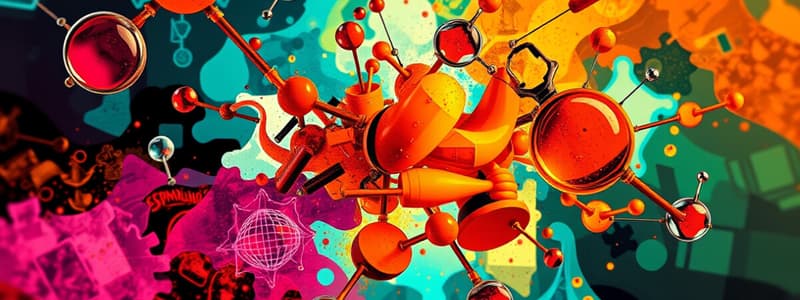Podcast
Questions and Answers
What does pharmacokinetics primarily study?
What does pharmacokinetics primarily study?
- The interactions between different classes of drugs
- The genetic influence on drug resistance
- The effects of drugs on cellular processes
- The absorption, distribution, metabolism, and excretion of drugs (correct)
Which of the following is NOT one of the four main pharmacokinetic processes?
Which of the following is NOT one of the four main pharmacokinetic processes?
- Respiration (correct)
- Excretion
- Absorption
- Distribution
Which statement best distinguishes pharmacodynamics from pharmacokinetics?
Which statement best distinguishes pharmacodynamics from pharmacokinetics?
- Pharmacodynamics analyzes the chemical composition of drugs.
- Pharmacodynamics studies drug concentration statistics.
- Pharmacodynamics examines how drugs affect the body. (correct)
- Pharmacodynamics is primarily concerned with drug creation.
Which factor does NOT generally influence pharmacokinetic processes?
Which factor does NOT generally influence pharmacokinetic processes?
How does pharmacokinetics contribute to medical practice?
How does pharmacokinetics contribute to medical practice?
Which process is primarily involved in determining how enzymes break down drugs?
Which process is primarily involved in determining how enzymes break down drugs?
Which of the following statements regarding Drug Y and Drug Z is true?
Which of the following statements regarding Drug Y and Drug Z is true?
What role do drug properties, such as protein binding and molecule size, play in pharmacokinetics?
What role do drug properties, such as protein binding and molecule size, play in pharmacokinetics?
Which factor does NOT affect the distribution of a drug from plasma to interstitium?
Which factor does NOT affect the distribution of a drug from plasma to interstitium?
Which statement accurately describes the blood flow to various organs?
Which statement accurately describes the blood flow to various organs?
What primarily determines capillary permeability?
What primarily determines capillary permeability?
Which tissue is likely to have the lowest rate of blood flow?
Which tissue is likely to have the lowest rate of blood flow?
Which condition would most affect the volume of distribution of a drug?
Which condition would most affect the volume of distribution of a drug?
Which region of the body is likely to have the greatest blood flow for distributing drugs?
Which region of the body is likely to have the greatest blood flow for distributing drugs?
What characterizes the capillaries in the liver and spleen regarding drug distribution?
What characterizes the capillaries in the liver and spleen regarding drug distribution?
How does the binding of drugs to plasma proteins affect drug distribution?
How does the binding of drugs to plasma proteins affect drug distribution?
What percentage of the administered dose is considered bioavailability if 60 mg of a 100 mg drug dose is absorbed unchanged?
What percentage of the administered dose is considered bioavailability if 60 mg of a 100 mg drug dose is absorbed unchanged?
Why is determining the bioavailability of a drug especially important for nonintravenous routes?
Why is determining the bioavailability of a drug especially important for nonintravenous routes?
What does P-glycoprotein primarily influence in drug pharmacokinetics?
What does P-glycoprotein primarily influence in drug pharmacokinetics?
What method is used to determine bioavailability by comparing drug levels?
What method is used to determine bioavailability by comparing drug levels?
What effect does the high expression of P-glycoprotein have on drug absorption?
What effect does the high expression of P-glycoprotein have on drug absorption?
Which of the following describes how the area under the curve (AUC) is used in pharmacokinetics?
Which of the following describes how the area under the curve (AUC) is used in pharmacokinetics?
What occurs to the drug reached via IV administration?
What occurs to the drug reached via IV administration?
Which concept describes the rate and extent to which a drug reaches systemic circulation?
Which concept describes the rate and extent to which a drug reaches systemic circulation?
What role does albumin play in drug distribution?
What role does albumin play in drug distribution?
Which characteristic of lipophilic drugs allows them to move across cell membranes easily?
Which characteristic of lipophilic drugs allows them to move across cell membranes easily?
What can result from tissue protein binding of drugs?
What can result from tissue protein binding of drugs?
What is a consequence of the continuous capillary structure in the brain for drug delivery?
What is a consequence of the continuous capillary structure in the brain for drug delivery?
How do hydrophilic drugs affect drug distribution in the body?
How do hydrophilic drugs affect drug distribution in the body?
Which statement about the binding of drugs to plasma proteins is true?
Which statement about the binding of drugs to plasma proteins is true?
What is a primary limitation of hydrophilic drug molecules in terms of distribution?
What is a primary limitation of hydrophilic drug molecules in terms of distribution?
Which of the following best describes the action of drug reservoirs in tissues?
Which of the following best describes the action of drug reservoirs in tissues?
What defines pharmacodynamics in the context of pharmacology?
What defines pharmacodynamics in the context of pharmacology?
What role do receptors play in drug action?
What role do receptors play in drug action?
Which statement best describes intrinsic efficacy?
Which statement best describes intrinsic efficacy?
What is a common characteristic of antagonist drugs?
What is a common characteristic of antagonist drugs?
How does drug potency relate to receptor interaction?
How does drug potency relate to receptor interaction?
What distinguishes pharmacokinetics from pharmacodynamics?
What distinguishes pharmacokinetics from pharmacodynamics?
What is a ligand in pharmacology?
What is a ligand in pharmacology?
What impact does chronic kidney disease have on pharmacology?
What impact does chronic kidney disease have on pharmacology?
What effect does an increase in drug dosage have?
What effect does an increase in drug dosage have?
Which of the following best describes a ligand-gated channel?
Which of the following best describes a ligand-gated channel?
What determines the effectiveness and safety of drugs?
What determines the effectiveness and safety of drugs?
How can ligands influence cell function?
How can ligands influence cell function?
What is a primary focus of toxicology?
What is a primary focus of toxicology?
What kind of interaction occurs between an agonist and its receptor?
What kind of interaction occurs between an agonist and its receptor?
In the context of pharmacokinetics, why is the concept of bioavailability crucial for drug administration?
In the context of pharmacokinetics, why is the concept of bioavailability crucial for drug administration?
How does the pharmacokinetic process of metabolism influence drug action in the body?
How does the pharmacokinetic process of metabolism influence drug action in the body?
What effect do patient-specific factors have on the pharmacokinetics of a drug?
What effect do patient-specific factors have on the pharmacokinetics of a drug?
How would you differentiate between pharmacokinetics and pharmacodynamics in terms of drug interaction?
How would you differentiate between pharmacokinetics and pharmacodynamics in terms of drug interaction?
Why is the route of administration a critical consideration in pharmacokinetics?
Why is the route of administration a critical consideration in pharmacokinetics?
What role do specific carrier proteins play in active transport of drugs across the GI tract?
What role do specific carrier proteins play in active transport of drugs across the GI tract?
How do endocytosis and exocytosis differ in drug transport mechanisms?
How do endocytosis and exocytosis differ in drug transport mechanisms?
What is the significance of understanding drug distribution in relation to therapeutic efficacy?
What is the significance of understanding drug distribution in relation to therapeutic efficacy?
Why is gastrointestinal pH an important factor affecting oral drug absorption?
Why is gastrointestinal pH an important factor affecting oral drug absorption?
How do chemical characteristics of drugs influence pharmacokinetic processes?
How do chemical characteristics of drugs influence pharmacokinetic processes?
What role does protein binding play in pharmacokinetics, and how might it impact drug interactions?
What role does protein binding play in pharmacokinetics, and how might it impact drug interactions?
Describe the concentration gradient involved in the active transport of drugs.
Describe the concentration gradient involved in the active transport of drugs.
What is the significance of the vesicular mechanisms of endocytosis and exocytosis in drug transport?
What is the significance of the vesicular mechanisms of endocytosis and exocytosis in drug transport?
How can other cotransported substances affect the active transport of drugs?
How can other cotransported substances affect the active transport of drugs?
What effect does the intestinal permeability have on drug absorption?
What effect does the intestinal permeability have on drug absorption?
In what way does the differentiation of pH levels in various GI tract regions affect drug absorption?
In what way does the differentiation of pH levels in various GI tract regions affect drug absorption?
What is the significance of understanding drug-receptor interactions in pharmacology?
What is the significance of understanding drug-receptor interactions in pharmacology?
Explain the concept of intrinsic efficacy in relation to drug action.
Explain the concept of intrinsic efficacy in relation to drug action.
How do different ligands affect receptor activation?
How do different ligands affect receptor activation?
What role do receptor affinities play in pharmacodynamics?
What role do receptor affinities play in pharmacodynamics?
Discuss the impact of chronic kidney diseases on drug pharmacology.
Discuss the impact of chronic kidney diseases on drug pharmacology.
How does an increase in drug dosage relate to receptor saturation?
How does an increase in drug dosage relate to receptor saturation?
What distinguishes agonist from antagonist drugs in their interaction with receptors?
What distinguishes agonist from antagonist drugs in their interaction with receptors?
In what ways can ligands be categorized in pharmacology?
In what ways can ligands be categorized in pharmacology?
Describe the relevance of pharmacodynamics in medication management.
Describe the relevance of pharmacodynamics in medication management.
What role does intrinsic efficacy play in differentiating drug effectiveness?
What role does intrinsic efficacy play in differentiating drug effectiveness?
Explain the process of ligand binding in relation to drug action.
Explain the process of ligand binding in relation to drug action.
How does receptor differential expression influence pharmacological responses?
How does receptor differential expression influence pharmacological responses?
What are ligand-gated channels and their significance in pharmacology?
What are ligand-gated channels and their significance in pharmacology?
In what ways do pharmacodynamics and pharmacokinetics differ in their focus?
In what ways do pharmacodynamics and pharmacokinetics differ in their focus?
How does the binding of drugs to albumin affect their distribution in the body?
How does the binding of drugs to albumin affect their distribution in the body?
What distinguishes lipophilic drugs from hydrophilic drugs in terms of cell membrane permeability?
What distinguishes lipophilic drugs from hydrophilic drugs in terms of cell membrane permeability?
Why can tissue protein binding lead to local drug toxicity?
Why can tissue protein binding lead to local drug toxicity?
What is the consequence of the brain's continuous capillary structure on drug delivery?
What is the consequence of the brain's continuous capillary structure on drug delivery?
How does the concentration of free drug in Plasma relate to drug binding dynamics?
How does the concentration of free drug in Plasma relate to drug binding dynamics?
In what way does the chemical nature of a drug influence its pharmacokinetic behavior?
In what way does the chemical nature of a drug influence its pharmacokinetic behavior?
How might drug distribution be altered in a patient with chronic kidney disease?
How might drug distribution be altered in a patient with chronic kidney disease?
Describe the role of tissue reservoirs in drug pharmacokinetics.
Describe the role of tissue reservoirs in drug pharmacokinetics.
What is the primary difference between agonists and antagonists in drug-receptor interactions?
What is the primary difference between agonists and antagonists in drug-receptor interactions?
How does the concept of potency relate to drug affinity and efficacy?
How does the concept of potency relate to drug affinity and efficacy?
Define the term 'maximal efficacy' in the context of dose-response relationships.
Define the term 'maximal efficacy' in the context of dose-response relationships.
What role does the slope of a dose-response curve play in pharmacodynamics?
What role does the slope of a dose-response curve play in pharmacodynamics?
What distinguishes partial agonists from full agonists in pharmacological terms?
What distinguishes partial agonists from full agonists in pharmacological terms?
How do the concepts of affinity and efficacy impact the effectiveness of a drug?
How do the concepts of affinity and efficacy impact the effectiveness of a drug?
Illustrate how a dose-response curve can be used to compare the potency of two different drugs.
Illustrate how a dose-response curve can be used to compare the potency of two different drugs.
What is the significance of the 'ceiling effect' in pharmacodynamics?
What is the significance of the 'ceiling effect' in pharmacodynamics?
Explain the importance of understanding drug-receptor interactions in the field of pharmacology.
Explain the importance of understanding drug-receptor interactions in the field of pharmacology.
What determines the dose-response relationship of a drug?
What determines the dose-response relationship of a drug?
Flashcards are hidden until you start studying
Study Notes
Pharmacology
- Defined as the scientific study of drug effects on living organisms.
- Drugs are natural or synthetic substances that impact biological systems.
Importance of Pharmacology
- Provides understanding of the biochemical and physiological effects of drugs.
- Assists in determining drug effectiveness and safety.
- Aids in disease diagnosis, prevention, and treatment.
Toxicology
- Field studying harmful effects of chemicals and substances on living organisms and the environment.
Concept of Receptors in Pharmacology
- Receptors are macromolecules located on cell membranes or inside cells.
- Receptors bind specifically to ligands (drugs) based on chemical interactions.
Drug–Receptor Interactions
- Concerned with the capacity of drugs to affect specific receptors.
- Drug affinity indicates the likelihood of binding to receptors.
- Intrinsic efficacy indicates a drug's ability to activate receptors and cause cellular responses.
Ligands
- Can be anions, cations, or neutral molecules that bond to metal ions.
- Serve as chemical messengers, binding to proteins to produce signals.
- Can be organic or inorganic, natural or synthetic.
Relationship between Ligands and Pharmacology
- Ligands include neurotransmitters, hormones, and drugs that bind to cellular receptors.
- Binding can be reversible or irreversible, activating or inactivating receptors and altering cell functions.
Ligand-Gated Channels
- Example: Acetylcholine binds to channel proteins, opening them for selective ion passage (sodium, calcium, potassium).
Drug Effect Dependence
- Disease States: Chronic conditions (e.g., kidney disease) significantly affect pharmacology.
- Number of Receptors: Changes in receptor expression influence biological responses.
- Drug Dosage: Increased dosages enhance effects until receptor saturation occurs.
- Drug Potency/Affinity: Higher potency means faster drug-receptor binding and slower release.
- Drug Efficacy: Measures a drug's ability to activate or block receptor functions.
Types of Drugs Based on Receptor Interactions
- Agonist Drugs: Fit closely to receptor sites and induce a response.
- Antagonist Drugs: Partly fit receptor sites, blocking normal responses without producing an effect.
Two Areas of Pharmacology
- Pharmacodynamics: Studies drug effects on the body.
- Pharmacokinetics: Studies how biological systems interact with drugs.
Pharmacokinetics
- Concerns absorption, distribution, metabolism, and excretion (ADME) of drugs.
- Influenced by patient factors (sex, age, genetics) and drug properties (binding affinity, size).
Bioavailability
- Refers to the rate and extent a drug reaches systemic circulation.
- Example of bioavailability calculation: If 100 mg administered orally results in 60 mg reaching the bloodstream, bioavailability is 60%.
Drug Distribution
- The process by which drugs leave the bloodstream to enter tissues.
- Factors influencing distribution: blood flow, capillary permeability, drug binding to proteins, lipophilicity, and volume of distribution.
Blood Flow
- Varies significantly among tissues; high in liver, kidneys, and brain compared to skeletal muscles.
Capillary Permeability
- Influenced by the structure of capillaries and the chemical nature of drugs.
- Variability in permeability across organs, affecting drug passage.
Drug Binding
- To Plasma Proteins: Binding isolates drugs, slowing their transfer out of blood circulation. Albumin serves as a primary binding protein.
- To Tissue Proteins: Can lead to higher drug concentrations in tissues, potentially causing local toxicity.
Lipophilicity
- Determines a drug's ability to cross cell membranes.
- Lipophilic drugs easily traverse membranes, while hydrophilic drugs have limited penetration.
Pharmacology Overview
- Pharmacology is the scientific study of drug effects on living organisms.
- Drugs can be natural or synthetic substances affecting biological systems.
Importance of Pharmacology
- Understanding biochemical and physiological drug effects is crucial.
- Pharmacology aids in determining drug effectiveness and safety.
- It plays a vital role in diagnosing, preventing, and treating diseases.
Toxicology
- Toxicology focuses on harmful effects of chemicals on organisms and the environment.
- It studies adverse reactions caused by various substances.
Receptors in Pharmacology
- Receptors are macromolecules located on cell membranes or within cells that bind specific ligands (drugs).
- Drug-receptor binding is influenced by various chemical interactions.
Drug–Receptor Interactions
- Drugs affect receptors based on their affinity (strength) and intrinsic efficacy (ability to activate receptors).
- Agonists fully activate receptors, while antagonists partially fit and block responses without activation.
Ligands
- Ligands can be cations, anions, or neutral molecules that bind to proteins to transmit chemical signals.
- They can be organic or inorganic, and natural or synthetic.
Receptor Activation
- Ligands bind to cellular receptors, resulting in activation or inactivation, which affects cell function.
- The binding can be reversible or irreversible depending on the ligand.
Ligand-Gated Channels
- Acetylcholine acts as a ligand, binding to ion channels, allowing cations like sodium and calcium to flow through.
Factors Affecting Drug Effect
- Disease states (e.g., chronic kidney disease) significantly impact drug pharmacology.
- The number of receptors and their differential expression mediate biological responses.
- Drug dosage determines effects; higher doses can lead to saturation of receptors.
- Drug potency relates to binding speed and release from receptors.
- Drug efficacy refers to its ability to block or activate receptor functions.
Areas of Pharmacology
- Pharmacodynamics studies how drugs affect the body.
- Pharmacokinetics examines how the body interacts with drugs, covering absorption, distribution, metabolism, and excretion (ADME).
Dose-Response Relationship
- The dose-response relationship is crucial in pharmacodynamics, showing how a drug's effect depends on its concentration at the receptor.
- Data is represented graphically, with dose on the x-axis and response on the y-axis.
Dose-Response Curves
- The dose-response curve demonstrates maximal efficacy and the potency of drugs.
- Potency is determined by how quickly a drug produces a response, while maximal efficacy denotes the highest effect achieved.
Mechanisms of Drug Absorption
- Drug absorption from the gastrointestinal tract can occur through active transport, endocytosis, or exocytosis.
- Active transport requires energy (ATP) and specific proteins to move drugs against a concentration gradient.
Factors Influencing Absorption
- The pH of the gastrointestinal tract significantly affects drug solubility and absorption.
- Different regions have varying absorptive properties.
Drug Distribution
- Drugs bind to plasma proteins (mainly albumin), isolating them and slowing transfer to tissues.
- Tissue binding can lead to prolonged action or local toxicity of the drug.
Lipophilicity in Distribution
- Lipophilic drugs easily cross cell membranes, while hydrophilic drugs struggle and must pass through junctions.
Pharmacokinetics vs. Pharmacodynamics
- Pharmacokinetics: What the body does to the drug (ADME).
- Pharmacodynamics: What the drug does to the body, focusing on molecular and biochemical effects.
Studying That Suits You
Use AI to generate personalized quizzes and flashcards to suit your learning preferences.




